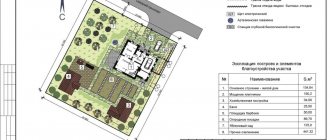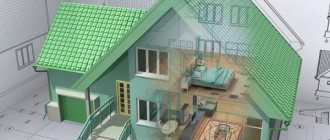It often happens that there is an idea to build a house, but there is no idea where to start.
It is because of this that many site owners rush to extremes, starting work that is not planned. To build a house from scratch, in order to competently carry out all construction work, you must have a clear plan before starting.
Construction companies help with this, but you can figure out the process yourself: to do this, it is recommended to familiarize yourself with the main stages of constructing a home.
Why is it important to know the procedure?
The image of a house appears in the minds of the owners of the site, but often few people know how to apply this image in practice. I would like to immediately have a finished house, move into it and live there, but in reality construction drags on for years, decades, especially if you don’t know the stages of housing construction.
Why is it so important to know all the steps to build a house on the site:
- This will help prevent mistakes during construction. It doesn’t matter whether the house will be built on its own or a contractor will be invited, the owner must be aware of the work taking place. There are also construction companies that sell a lot of services to the client, but the client himself does not know whether their proposals are correct. Therefore, before you take on the construction of a new building, it is better to find out what stages and in what sequence are performed for this.
- This will help save money. Overspending on construction materials is one of the main problems when allocating a budget. If you don’t calculate in advance how much the house will cost, and don’t think through the amount of materials, you’ll have to constantly spend more. Construction is already associated with regular expenses, but if the owner has an estimate, it will be easier to save money.
- This will help avoid problems with the law. It is known that all residential buildings must be built in accordance with SNiP. This set of rules allows you to avoid emergency situations during construction and during operation. When registering a house, if it is built according to all standards, there will be no questions from the legislative bodies.
Knowing the stages of constructing a residential building provides many advantages. The owner can easily realize all his plans for future housing if he is informed during the construction process.
Process step by step
There are the following stages of building a house:
- G
geological and geodetic checks; - preparation of an architectural project;
- preparation of construction project and estimate;
- laying and installation of communications on the site;
- installation of a foundation for a house;
- construction of walls, partitions and ceilings;
- roofing work;
- installation of doors and windows;
- insulation and finishing of facades;
- installation of utilities inside the house;
- Finishing work.
Any construction begins with a search for a site, but if it is already owned, it is important to check all documents for their compliance with the law. To do this, contact a notary and the BTI.
When the documentation is ready, geological work is carried out on the site:
- take soil samples;
- determine the level of groundwater and the level of soil freezing in the region.
Geological work is necessary in order to choose what type of foundation is suitable for building a house.
Next, they develop architectural and construction projects - you can do this yourself or contact specialized companies. After this, estimate documentation must be prepared - this will give an idea of the possible costs.
The next stage will be the installation and installation of communications on the site. During construction, power tools are often used, so electricity must be supplied, as well as water. If there is a gas pipe nearby, then gas must also be piped to the site.
Next, choose the type of foundation and build it . Then they are engaged in arranging walls, floors, ceilings, and partitions. They make a roof, install windows and doors, and insulate the facades if necessary. At the final stages, communications are brought into the house and interior decoration is carried out.
I bought a plot, what’s next - a clear plan - everything is in the head
Often people neglect paperwork and prefer to immediately deal with more global issues, such as architectural design, foundation, etc. And then they grab their heads: after all, it turns out that their new foundation, after the removal of boundary signs, ended up on the territory of a neighbor. I would say that the land surveying process is a very controversial topic, full of litigation...
Remember one truth , thanks to which you can avoid many problems throughout the entire construction: Any of your actions should begin with “paperwork”, with a thorough solution to the problem, first on paper, and then transferring them to reality!
Anyone who neglects this sooner or later falls into the trap of “unsolvable problems.” I would say that building a house is easier than sorting out all the papers, coordinating everything and going through the seven circles of bureaucratic hell...
First you need to finally understand the boundaries of your site. I have already written in this article about the role land surveying plays. And he emphasized that it is advisable to purchase a privatized plot, with a land surveying plan already developed. But often life adjusts our plans.
So let’s look at the privatization and land surveying procedures in detail, in case you didn’t buy the land, but you got it due to other circumstances: I’ve put them in separate posts so as not to overload the article
Privatization of land
Land surveying
And finally, when we completely figured out the design of the site and became its full owners, we were faced with a sacramental question:
Differences for permanent and country buildings
In general, the stages of building a country house and a house suitable for permanent residence will be identical.
The only difference will be the following:
- for a country house there is no need to connect all communications: for example, you can do without gas;
- the design of a country house will be simpler;
- geodetic and geological work will be carried out in a simplified version.
Since country houses are intended for seasonal living, the stage of insulating the facades can be omitted. In addition, all construction work will be faster and easier, since there is no scale.
Compare popular materials for building a house:
Brick
| pros | Minuses |
|
|
Foam blocks
| pros | Minuses |
|
|
Aerated concrete blocks
| pros | Minuses |
|
|
Arbolit
| pros | Minuses |
|
|
Frame or modular construction
| pros | Minuses |
|
|
Tree
| pros | Minuses |
|
|
A wooden house belongs to the category of environmentally friendly housing; it has natural ventilation and, if all technologies are followed, perfectly retains heat. During construction, try to prevent severe shrinkage and the formation of cracks: choose high-quality dry wood, do not forget to thoroughly caulk the frame.
Materials from which wooden houses are built:
- rounded logs;
- profiled timber: wood that has been processed with the addition of tenons and grooves;
- glued laminated timber: boards glued together.
Rules for construction on land plots
As mentioned above, there are construction norms and rules that must be followed.
They touch:
- purpose of land (land can be intended for individual construction, or maybe only for garden houses);
- size and area of the site;
- sanitary standards;
- fire safety;
- distances between buildings.
It is also important to take into account the norms for the indentation of objects from the border:
- with neighbors;
- tree planting standards;
- construction of additional facilities, such as a bathhouse and a garage.
The rules for installing a fence on a plot of land are also important.
Legislative regulation
To start building a house on a plot of land, it is recommended to look at the following documents :
SNiP 30-02-97.
This code regulates the planning and development of the territories of gardening associations of citizens, buildings and structures. The regulation states how to determine the location of objects on a site relative to its boundaries.- SNiP 2.07.01-89. It tells about the planning and development of urban and rural settlements. The act defines the rules for laying pipelines and water supply between different sections.
- SNiP 2.04.01-85. He will tell you about the standards for laying internal water supply and sewerage systems.
- SNiP 2.04.08-87. Will tell you about gas supply standards at the site.
All these sets of rules will help you understand housing construction legislation at its initial stage.
Learn more about the standards and rules for building a house on a self-storage basis here.
Fencing the site and creating a recreation area
The fence between areas should be no higher than 1.5 meters, mesh or lattice. This is necessary for good lighting, because a high solid fence can damage the vegetation of neighbors.
But sometimes solid fences don’t bother your neighbors, then you can reach an agreement with them and even consolidate the agreement reached in writing. In this case, there is nothing to fear, except perhaps a change of owners, because the next ones will no longer be obliged to fulfill this agreement. For the part of the fence facing the street, the requirements are different: the height can reach 2 meters, there are no requirements for transparency.
The construction of the fence is usually carried out after the work on connecting communications has been completed and large materials for the construction of structures have been delivered.
The recreation area should be tackled when everything else is already completed. How big it will be, what kind of structures and decor it will have, as well as other parameters are determined by the purpose of the site. It can serve as a place of permanent residence, a place of rest or a summer cottage - with each of these options the arrangement is carried out differently.
For example, when using the entire site as a recreation area, the lion's share of the area is allocated to this zone; massive objects, such as an alpine slide or a pond, can be placed on it. If this is a summer cottage, most often its area is small and everything is limited to a flower garden, a place for preparing barbecue, or a gazebo.
When all the zones are equipped, all that remains is to lay working paths, and flower beds or shrubs along them. After this, the site can be considered equipped - in parallel with the listed activities, the construction of a house is usually carried out, so that after all the work is completed, you can finally relax and enjoy the result of the transformations carried out.
How to choose the right project for a country cottage?
In order not to get lost in the wide variety of types of houses, it is recommended to understand what they are like :
- garden or country houses;
- cottages;
- country houses for permanent residence.
Garden or country houses are intended for seasonal living. From the point of view of insulation, the requirements here will be lower, and the project will also be simpler. This reduces the cost of building such housing.
Cottages are spacious buildings for temporary or permanent residence. Their cost is higher, since the requirements are also higher. Houses in a village or cottage community are intended for permanent residence, so they will be supplied with all communications, insulation, they can be two-story or attic.
To choose the right project, it is important to pay attention to the following criteria :
- this is a characteristic of the soil on the site;
- choosing the type of foundation depending on the terrain;
- the size of the plot and the area of the house itself.
You can contact an architectural bureau, but first draw out your wishes on a piece of paper yourself.
Read more about the types of houses here.
Features of the installation stages of construction of a private house
The stages of construction of a residential building and their sequence are practically independent of the materials used or technologies of installation processes.
Preparatory stage
Site selection. The key points of choice are the availability of transport infrastructure and utilities. The purpose of the site is also clarified. So, if you plan to build a house for permanent residence with the need for registration, then the intended purpose should be “for residential construction.”
Engineering and geodetic work. Ideally, they should be carried out before purchasing a land plot. For example, the structure of the soil and the proximity of groundwater will determine the design of the foundation being built, its labor intensity and cost.
Design. The development of design and estimate documentation is necessary both for obtaining a construction permit and for obtaining a mortgage. It should be taken into account that the cost of building a house included in the estimate serves as an approximate value. Prices for building materials and work are changing, mostly upward. In addition, project adjustments and unforeseen expenses are inevitable.
Axle breakdown. If the site is fairly level and the type of soil allows you to do without preliminary removal of the fertile layer, the main contours of the building are transferred from the plan directly to the construction site. The result of this stage should be a signed axle layout act and an as-built diagram.
Notification of the start of construction and permission
One of the documents about the start of construction is a notification that is submitted to the official authorities. To submit it, you need to fill out a special form.
The notification contains information about:
- owner, data about the plot (for this you need an extract from the Unified State Register), data about the future house;
- site plan with outlines of the house.
In this case, the site must undergo a land surveying procedure so that its boundaries are shown on the plan. Permission to build a house is no longer required.
Until 2021, the Town Planning Code of the Russian Federation assumed the existence of this document, but it was later abolished. At this time, only notification is required.
Even more information in this article.
Construction of a house frame
The frame is a critical stage in the construction of this type of house. When installing it, it is recommended to use metal mounting elements or self-tapping screws, but not nails. The gap between the racks will depend on the width of the insulating material and finishing structures, otherwise the developer will need to install auxiliary racks at the junction points. The racks are made of timber 150x150 or 150x200, which is acceptable for the further installation of thermal insulation elements.
During the installation process, temporary jibs are installed to prevent the wall systems from being beveled in any direction. Vertical posts are reinforced with horizontal jumpers, which are attached with corners to prevent the formation of cracks and distortions. After all the racks are secured, the upper one is installed using the bottom strapping technology. To ensure the stability of building structures, the frame is secured with diagonal braces, and fencing systems for window and door openings are installed.
List of documents
To formalize the start of construction of a house in accordance with all laws, it is important to prepare the necessary documents :
resolution on the provision of a land plot for individual housing construction;- purchase and sale agreement (if available);
- general plan;
- site passport;
- act on establishing the land boundaries of the site;
- private residential building project.
The project includes information such as:
- situational plan;
- communications wiring diagram;
- floor plans;
- facades;
- cuts;
- topographic survey of the adjacent part of the street, as well as a general plan of the site;
- basement plan;
- foundation;
- roofs;
- roof truss system.
Read more about the documents here.
Construction permit without design documentation
The next question is: is it possible to obtain a construction permit in the absence of design documentation? The answer is contained in Art. 51 Civil Code of the Russian Federation:
Paragraph 1
– a construction permit is a document confirming the compliance of project documentation with the requirements of the urban planning plan of the land plot and giving the developer the right to carry out construction, reconstruction of capital construction projects, as well as their major repairs, except for cases provided for by this Code.
Clause 9
– for the purpose of construction, reconstruction, major repairs of an individual housing construction project, the developer sends an application for issuing a permit to the authorities authorized to issue construction permits in accordance with parts 4-6 of this article; for construction. The following documents are attached to this application:
Clause 10
– it is not allowed to require other documents to obtain a construction permit, with the exception of the documents specified in parts 7 and 9 of this article.
Clause 11
– The federal executive body, the executive body of the constituent entity of the Russian Federation or the local government authority authorized to issue construction permits within ten days from the date of receipt of the application for issuing a construction permit.
Clause 14
– refusal to issue a building permit can be challenged by the developer in court.
Layout of buildings on the site
Clause 15
– The issuance of a construction permit is carried out by the federal executive body, the executive body of a constituent entity of the Russian Federation or a local government body authorized to issue a construction permit without charging a fee.
Clause 18
– The developer, within ten days from the date of receipt of the construction permit, is obliged to transfer free of charge to the federal executive body, the executive body of the constituent entity of the Russian Federation or the local government body that issued the construction permit, information about the area, height and number of floors of the planned capital construction project , on networks of engineering and technical support, one copy of a copy of the results of engineering surveys and one copy of copies of sections of the design documentation provided for in paragraphs 2, 8-10 of part 12 of Article 48 of this Code, or one copy of a copy of the planning organization diagram of the land plot indicating the location individual housing construction object for placement in the information system for supporting urban planning activities.
Clause 19
– A building permit is issued for the period specified in the project for organizing the construction of a capital construction project. A permit for individual housing construction is issued for ten years.
To summarize, we summarize the following: when building an individual house on your own site, a building permit is not required. But from the department of a local architectural bureau or from a design organization, you will need to order a plan for the planning organization of the land plot, which is a plan of your site indicating:
- site boundaries;
- red building line;
- boundaries of permissible zones for the construction of residential buildings;
- permissible zones for the placement of outbuildings, and so on.
You must indicate the expected overall dimensions of the future home yourself.
House project (IZHS)
Preparing land for development
To prepare the land on the site for building your own home, you need to complete an action plan :
- Check the communications system laid on the site.
- Clean the area: remove old trees, stumps, branches and debris.
- Carry out excavation work. This includes determining the groundwater level, soil composition and type. Analysis is necessary to understand which foundation will be preferable.
- Install utility rooms on the site that will be intended for storing tools or housing workers.
You can do all this on your own, but if you contact a specialized company, they will perform this list of services.
Read more at the link.
Getting a house project
Knowing where to start building a house step by step, you can decide what type of building is right for you and how many rooms there should be. The next step is to order a project from a professional. How to do it:
- We buy a ready-made project. The price for it starts from 3 thousand rubles. The more complex and unusual the project, the higher the cost.
- We turn to the architect. The price for developing an individual project starts from 20,000 rubles. By the way, in order for the creator of the project to control its implementation, you will also have to pay.
- We develop a house project on our own. However, in this case, you must understand how to do it.
You can also order a project from a construction company that will build your house.
Even if you use a ready-made project, you can make changes to the arrangement of rooms or the roof configuration. Most construction companies will take your wishes into account and change the project, for example, moving a couple of partitions inside the cottage. However, in this case, be prepared for additional expenses.
Organization of the site
Preparing a construction site is one of the initial stages. This is a set of measures for clearing, cleaning, and dismantling structures on the territory. This includes work such as :
fencing the territory;- dismantling and demolition of all existing buildings;
- rerouting of communications;
- laying temporary communications;
- protection of the site from surface waters;
- organization of temporary access roads.
If the site was already owned and gas was supplied to it, but the pipe was located low, this could cause difficulties when operating construction equipment, for example, a crane. To do this, it is necessary to reroute the gas pipeline and raise the pipe higher.
Full article about the organization here.
Creation of temporary fences
Temporary fences are fence structures that are installed around the perimeter of the site. Their main task is to determine the boundaries of the territory and create an obstacle to free movement around the site. A temporary fence is made without a foundation.
Such fencing is necessary on the construction site. You can build it with your own hands in a short period of time. Most often it is made from chain-link mesh, corrugated sheets or lumber.
There is even more information about temporary fencing here.
Where to begin
Building a cottage is a very expensive undertaking. Therefore, first of all, it is necessary to resolve the issues of project financing. If you do not have enough funds for this, you can partially or fully receive them in the following ways:
Mortgage. Different banks may have special requirements for receiving funds for construction. For example, to the age, work experience, income of the borrower. However, the presence of collateral is often required - the land plot on which construction is being carried out, other real estate or valuable property.
Maternity capital (as of 2021 – 453 thousand rubles). It is clear that this amount is not enough to build a full-fledged house. However, several ways of using maternity capital for construction are practiced:
- purchase of building materials;
- payment of the mortgage, both its down payment and interest on the loan.
You can spend maternity capital on building a house only if the land plot is already owned and you have a building permit. In this case, the house must be capital - have a stationary foundation and load-bearing structures, as well as a connection to utilities (water supply, sewerage, gas supply), subject to their availability in the locality.
Important! You cannot spend maternity capital for the construction of DPN or SNT (dacha or garden partnerships) on land plots, as well as for the acquisition of a land plot.
Subsidy is social gratuitous assistance issued for the construction of a residential building. It can be provided for the construction of a new one or as compensation for the costs of a completed structure. The decision to issue a subsidy is made by the local administration, guided by fairly strict restrictions. Thus, the need to improve living conditions, the lack of previously provided assistance from the state, the availability of permits for construction and ownership of the site are taken into account. Subsidy funds are not issued in person, but are paid to the developer upon provision of an estimate or used to purchase building materials by bank transfer.
Storage layout
There are a number of rules and nuances when planning a construction site:
- To begin with, they determine the nature of the soil of the earth. If the groundwater level is high, then drainage work must be carried out. If the aquifer is deep, the location for drilling the well is determined.
- Mutual arrangement of buildings. Often, when planning, they include such capital construction projects as a residential building, outbuildings, a recreation area, a garage, a sauna, a children's playground, and a garden area. All this must be arranged organically and maintaining the permissible distance between them.
The location for the house is chosen depending on the terrain. If there is a hill on an empty plot, then it is better to place the house there. There are central, deep and front landings of the house. Outbuildings are located away from the house. The garage is located as close to the exit as possible.
Planning rules for different plot sizes are in the section at the link.
Planning and zoning
You can start planning at the same time as completing the paperwork. To begin with, you should study the plot you have received in more detail. Go around it and examine the plants with buildings. Think about what is worth keeping and what is better to get rid of, what is missing, whether any plants require pruning of branches - and so on. If you have not yet made acquaintance with your neighbors, then it is time to do so. You can find out from your neighbors where to go in case of various types of incidents. It is also worth studying how garbage is removed, checking the quality of water, and examining the soil.
It is best to hire the services of a specialist to conduct a geodetic survey: he will determine the type of soil and water level, and draw up a relief plan. Based on the results of his work, it will be easier to decide whether something is worth rebuilding in the area.
Although the type of soil can be determined independently, many do not apply for research. The plants on the site will serve as a hint: if there is a lot of horsetail, plantain, and sparrow sorrel on it, the soil is acidic; coltsfoot, bindweed, meadow and creeping clover, fragrant chamomile love slightly acidic and neutral soils; stinging nettle grows on rich and fertile soil.
When planning, it is also worth considering the direction of the winds - determining which places are well protected from them, where the sun's rays most often fall. If the site is completely clear of buildings, you should immediately decide whether you will need a “temporary structure” on it, or whether you will immediately begin building a house.
Next, you can start drawing up a plan. The site must be divided into several mandatory zones: utility, garden, vegetable garden and recreation area. Select them and make a detailed plan with all the buildings that you will need. A landscape design specialist will help you arrange all the objects in the best way and draw up a plan - his services will be especially useful if the site has complex terrain that needs to be taken into account, or there are already many objects on it and you are going to completely reorganize it.
The plan should indicate communication routes, as well as the entrance. Since the entrance is quite wide, and the land allocated for it cannot be used for anything else, it is worth thinking through everything so that it does not go too deep into the yard.
When the plan is drawn up, it is worth working out plans for each zone separately and drawing them. When drawing up a plan, it is worth complying with the established requirements: this is the only way in the future it will be possible to register the house - for this you will need to collect a lot of documents, including compliance with all regulations on the site.
For example, a residential building must be at least 3 meters from the border of the site; light buildings for animals - at least 4 meters, other buildings - at least a meter. The location should be such that the buildings cast a shadow on the neighboring area as little as possible.
Trees and shrubs should also not grow close to the border: for the latter, the minimum distance from the trunk is one meter, for trees of medium height - two, and tall - four. Planting a hedge is allowed, but appropriate plants must be used for it - the main thing is that they do not form new shoots in the neighboring area.
If there is no centralized sewage system, the sanitary zone is required to be located at least 15 meters from residential premises, and the drains should be directed past the garden.
Main mistakes
At the pre-construction stage, one of the main mistakes is incomplete paperwork. If this is not done, then in the future, when the house is already built, you may receive a fine for non-compliance with standards. In addition, if land surveying is not carried out, you can sue your neighbors for a long time over 20 cm of fence.
At the start of construction, the following errors may occur :
discrepancy between the bearing capacity of the soil and the weight of the house;- insufficiently strong foundation;
- insufficient protection of the base from moisture and frost;
- incorrectly prepared architectural design;
- lack of estimate;
- incomplete clearing of the site for construction;
- improper placement of buildings on the land plot.
To avoid problems in the future, it is recommended to immediately work out an action plan, make a design of the house and land, and also formalize everything in accordance with the law.
Without project and estimate
What happens
if the developer tries to build a relationship with the contractor without a project and estimate.
It is good if the mutual understanding with the contractor reached at the start of the project is maintained until its completion. But what to do if at some point the desired understanding disappeared, or perhaps developed into rejection?
Very often in this case the case goes to court, and the construction company that started and carried out the construction of a house without a project will most likely lose this court. Its only salvation is if you sign the following phrase in the contract: “The customer insists that the house will be built without a design, and assumes all responsibility, including negative consequences.” I very much doubt that you will agree to sign such an agreement. And a conscientious, responsible contractor will not agree to work without a project.
But it’s quite the opposite with small offices and private teams. They, unlike serious companies, will be happy to build without a project, because they understand that without a project and estimates they can build as they want, as quickly and easily as possible.
And most importantly, you will always have to pay them extra for everything,
because you will constantly hear from them the phrase: “We didn’t agree on this, we need to pay extra!”
And later, when you realize that the budget is overspending and they built something far from what you wanted
, you will hear in response: “E khazyaIn, you yourself hatEl, and so they did it...”.
It will be useless to sue them, and what’s the point - time is wasted, and alterations will cost even more.
So if you have a lot of money and time
, there is an opportunity to “live” at a construction site in order to manage the process that you have in your head, then construction without drawings, estimates and projects is for you.
How to obtain permission to build individual housing construction?
Having read articles 48 and 51 of the Town Planning Code of the Russian Federation, we can say that a permit for the construction of an individual residential building is a document issued in the manner prescribed by law and confirming the compliance of the design documentation with the town planning plan and the territory planning project.
On a note! For individual housing construction, a construction permit is one of the most necessary documents. Moreover, without a construction permit, individual housing construction may simply be in jeopardy, since without it it is impossible, for example, to take out a loan for construction and much more.
Based on the main points of Articles 48 and 51 of the Town Planning Code of the Russian Federation, presented above, we will discuss what documents are necessary for the construction of an individual residential building.
What documents are needed to obtain permission to build individual housing construction?
First you need to define the concept of individual housing construction. An individual residential building is a detached house with a height of no more than 3 floors, intended for residence of no more than one family. Moreover, the construction of mixed-storey houses and townhouses on the site is not allowed.
To obtain permission to build an individual residential building (IHC), the owner or tenant of the plot writes an application in the established form with the following documents attached to the administration of the district in which your land plot is located, or to the architectural department:
- Title documents for the land plot (certificate of ownership or lease right and cadastral passport of the land plot).
- Urban development plan of the land plot (GPZU).
- Scheme of planning organization of a land plot (SPOZU) indicating the location of an individual housing construction object, agreed upon with the district architect.
- Consent of all rights holders of a capital construction project in the case of reconstruction of an individual residential building with the attachment of title documents for the residential building.
- Developer's passport details.
- At the request of the developer, design documentation. It is recommended to have an architectural passport of the house project.
Sample OSD
Architectural passport of the house project
An architectural passport is a document that contains basic information about the project. The composition of the project passport is similar to the preliminary design, which includes:
- title page;
- Total information;
- list of drawings;
- explanatory note;
- floor plans;
- roof plan;
- facades and sections.
The architectural passport of the project is needed not only to obtain a building permit. It is also useful for determining the preliminary cost of a home. The passport in no case replaces the project, since even with a competent approach to construction, it is impossible to build a house according to the architectural passport.
But, with a small construction budget, sometimes it is better to first make a preliminary assessment so as not to make a mistake in choosing a project for implementation.
On a note! In accordance with paragraph 10 of Article 51 of the Town Planning Code of the Russian Federation, the requirement of other documents in order to obtain a construction permit from the developer of an individual housing construction project is not allowed.
What does the administration check when receiving documents?
Within 30 days from the date the developer submits the application and provides the above documents, the following procedures are carried out:
- checking the availability of all documents attached to the application;
- checking the compliance of the design documentation or the land plot planning organization scheme (LPOSU) with the designation of the location of the individual housing construction object with the requirements of the urban planning plan of the land plot (GPZU) with red lines.
Application for a construction permit
The developer has the right to request permission to deviate from the maximum parameters of permitted construction or reconstruction. In this regard, the compliance of the design documentation (PD) or the planning organization of the land plot (LPOSU) will be checked for compliance with the requirements established in the construction permit.
If you are not issued a building permit, then you must be given a reasoned refusal to issue this document. The reasons for refusal to issue a building permit may be either the submission of an incomplete package of documents, or the non-compliance of the submitted documents with the requirements of the urban planning plan of the land plot.
Refusal to issue a construction permit is a document that can be appealed in court. If you are not issued a permit, then you must obtain a document confirming the refusal.
On a note! Please note that in accordance with the Town Planning Code, the issuance of a building permit is free of charge. The validity period of a permit for the construction of an individual residential building is 10 years.
Established application form for obtaining a permit
How is a building permit confirmed?
In accordance with Article 51 of the Town Planning Code of the Russian Federation, a construction permit:
- confirms the compliance of the project documentation with the requirements of the urban planning plan of the land plot (GPZU), and in the absence of an urban planning plan - with the permitted use of the site;
- gives the developer the right to carry out construction, reconstruction of real estate, as well as major repairs.
When selling a plot, the new owner no longer needs to obtain a building permit, unless its ten-year validity period has expired. Because the permit is not tied to a specific person, it is valid for the site as a whole.
What to do when a building permit has been received?
After a building permit has been received, the developer is obliged to provide the following information free of charge to the authority that issued the permit or the architectural administration body within 10 days:
- On the height and number of storeys of the planned capital construction facility.
- On engineering support networks (technical specifications for connection).
- Sections of project documentation or a planning organization diagram of a land plot (SPOZU) indicating the location of an individual housing construction project.
Subsequently, all this information is included in the information system for supporting urban planning activities.










